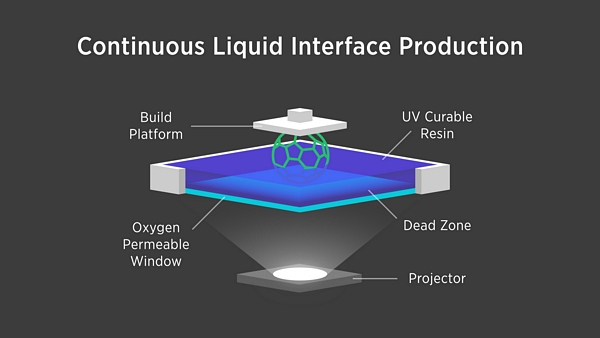Though 3D printing is definitely a revolutionary technology which is going to change the ways we manufacture things, there are various stumbling blocks preventing this technology from entering the mainstream. Print speed is one such stumbling block. It takes around 3-4 hrs just to print a 10 cubic cm object. At that speed, it is next to impossible to manufacture goods in bulk and thus the technology is getting restricted to prototyping or for manufacturing low volume goods. Lot of research is being conducted to break this print speed barrier. And today, we hear one such big news which will take 3D printing technology to the next level.
Carbon3D, a new company in 3D printing space has come out of the stealth mode with its new breakthrough 3D printing process which the company claims will be anywhere between 25 and 100 times faster than what is available on the market today. The company has built an entirely new technology called Continuous Liquid Interface Production (CLIP) which works by harnessing the power of light and oxygen to cure a photosensitive resin. The fundamentals of this technology are very similar to that of SLA technology where a UV light is used to cure photo-sensitive resin. But the major difference lies in the curing process.
How CLIP works:
SLA technology and for that matter in every other 3D printing technology available in the market, is just 2D printing in repeated iterations. Each object is printed layer by layer. As a result, 3D printed parts take many hours, even days, to produce and are mechanically weak due to their shale-like layers. Using a tunable photochemical process instead of the traditional mechanical approach, Carbon3D’s layerless continuous liquid interface production technology (CLIP) eliminates these shortcomings to rapidly transform 3D models into physical objects. By carefully balancing the interaction of UV light, which triggers photo polymerization, and oxygen, which inhibits the reaction, CLIP continuously grows objects from a pool of resin at speeds 25-100 times faster than traditional 3D printing.
Core part of the CLIP process is a special window that is transparent to light and permeable to oxygen. By controlling the oxygen flux through the window, CLIP creates a “dead zone” in the resin pool just tens of microns thick (about 2-3 diameters of a red blood cell) where photopolymerization cannot occur. As a series of cross-sectional images of a 3D model is played like a movie into the resin pool from underneath, the physical object emerges continuously from just above the dead zone. Conventionally made 3D printed parts are notorious for having mechanical properties that vary depending on the direction the parts were printed because of the layer-by-layer approach. Much more like injection-molded parts, CLIP produces consistent and predictable mechanical properties, smooth on the outside and solid on the inside.
CLIP technology has three major advantages when compared to existing 3D printing technologies. These include
- Game-Changing Speed: 25-100 times faster than conventional 3D printing
- Commercial Quality: produces objects with consistent mechanical properties
- Material Choice: enables a broad range of polymeric materials
“Current 3D printing technology has failed to deliver on its promise to revolutionize manufacturing,” said Dr. Joseph DeSimone, CEO and Co-Founder, Carbon3D. “Our CLIP technology offers the game-changing speed, consistent mechanical properties and choice of materials required for complex commercial quality parts.”
Venture Backing
Carbon3D is based out of Redwood City, California. It has a raised a Series A round of financing in 2013 from Sequoia Capital along with Northgate Partners, Piedmont Capital Partners and Wakefield Group. Silver Lake led the Series B round of financing in 2014 with Northgate Capital and Sequoia Capital and Carbon3D raised a total of $40 million to commercialize the technology.
“If 3D printing hopes to break out of the prototyping niche it has been trapped in for decades, we need to find a disruptive technology that attacks the problem from a fresh perspective and addresses 3D printing’s fundamental weaknesses,” said Jim Goetz, Carbon3D board member and Sequoia partner. “When we met Joe and saw what his team had invented, it was immediately clear to us that 3D printing would never be the same.”
“We had studied the additive manufacturing ecosystem comprehensively and had concluded that the promise far exceeded the current reality in the marketplace,” said Adam Grosser, Carbon3D board member and Managing Director at Silver Lake Kraftwerk. “When we witnessed the CLIP process, we believed we had found a company that had invented a solution to speed, quality, and material selection. We are proud to work alongside Carbon3D to create a new category of 3D manufacturing.”
We, at think3D really hope this technology will become commercial and will be priced within the reach of a common man. Then we can definitely 3D printing technology taking off in a big way in the global market and also in the Indian market.
Source: www.carbon3d.com

